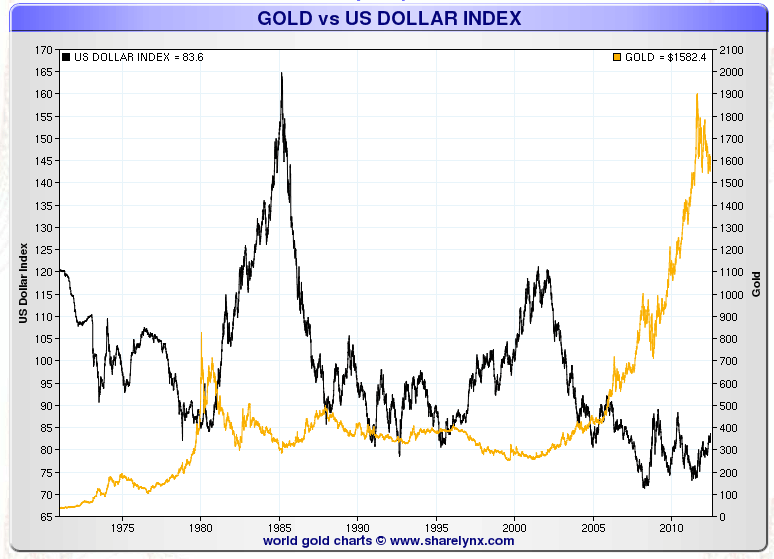Gold is visually attractive and its purity is easy to determine. This combination of characteristics can't be found in any other element or precious metal. It is almost as though gold, as an element was designed intentionally to be money. Gold's unique properties led to its use as a currency in the past, and that historical precedent may be the most important reason the metal is still used that way today.

Figure 1.1
Figure 1.1 shows how gold prices have reacted to the value of the dollar, since gold began to float more freely against U.S dollar.
Short History Lesson
1900 - Gold was adopted as the single metallic standard for U.S. money. The original standard of one dollar to the mexican peso or a fixed amount of silver.
1933 - During the Depression, President Roosevelt banned gold exporting and put a stop to convertibility of paper into gold. He also out law holding gold as an investment and ordered U.S. citizens to turn in the excess gold they owned to the U.S. government. This was not the first time this kind of action had been taken, and the United State was not the only country to do so during the Depression.
1973 - The United State officially ended the gold standard and allowed both the dollar and gold to float freely. The ban on ownership of gold as an investment also was lifted. Since that time the value of gold versus the dollar has moved up and down. If investors have grown fearful about the economy the gold prices rising and more confident gold price falling.
1980 - Gold prices hit an all-time high of USD$870 per once. The price of gold in inflation-adjusted dollar has never been higher than it was in 1980.
1997 and 1999 - The U.S. government approved gold as an asset that could be held in an individual retirement account (1997) and 15 of the largest central banks in the world signed an agreement to limit annual gold sales. The combined effect of these two events can be seen in the subsequent introduction of better gold investing products and renewed interest in gold as a store value. Small investors could more easily hold gold as an asset in their portfolio.
2000 - 2011 - The underlying presuure of new buyers and central banks combined with the market desruption of the "Great Recession" will push gold prices to all-time highs. The expandion of the U.S. money supply is contributing to the rise in gold prices because investors are fearful that the expansion of the money supply will lead to a decline in the dollar's purchasing power.
2011 - beyond - As one of the few realistic alternatives gold is important to investors and central banks. Asian central banks in particular are too concentrated in U.S. dollar assets and need to diversify into gold as a reserve assets. Thus kind of buying could have a very positive effect on the price of gold.
MOHD SULIMAN HAFID - PG 027857
Master Dealer for Singapore
SMS/WhatsApp +65 9224 6333 (Spore) +6 016 6825 003 (M'sia)
Like Us at Page OneGoldDinar
